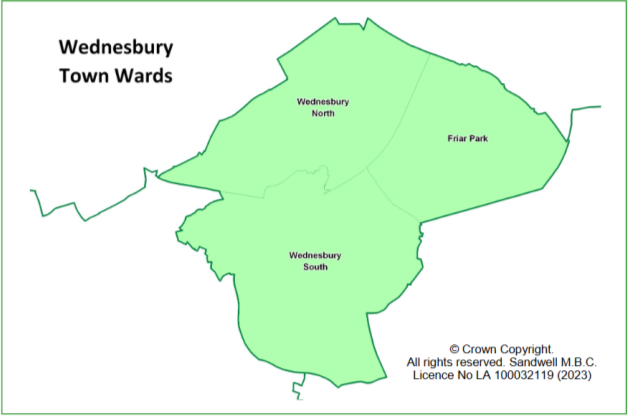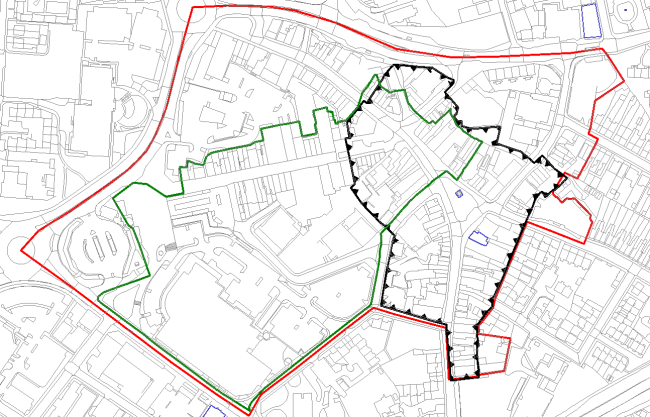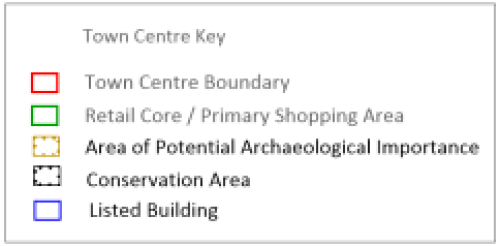Draft Regulation 18 Sandwell Local Plan
(1) Wednesbury Town

9.254 Wednesbury is a market town in the West Midlands, located approximately ten miles northwest of Birmingham and six miles southeast of Wolverhampton. Wednesbury is one of the six main towns of Sandwell, and is in the north of the borough, approximately three miles north of West Bromwich. The town contains the wards of Friar Park, Wednesbury North and Wednesbury South.
9.255 The population of Wednesbury in mid-2020 was estimated to be 39,491 with 19,503 males (49.4%), and 19,988 females (50.6%). Wednesbury has the smallest population of the six main towns in Sandwell. 18.6% of population are from ethnic minority backgrounds. Wednesbury has a proportionally older age profile than Sandwell, but a younger age profile than England on average.
9.256 Overall, Wednesbury is more deprived than England and compared to the rest of Sandwell, and its deprivation score would put it in the 20% most deprived areas in England. 26% of its residents are living in income deprived households and 13% are claiming job seekers' allowance.
9.257 Female and male healthy life expectancy were statistically significantly lower than the average for England in all three wards in Wednesbury. Healthy life expectancy for both females and males was lower than the present state pension age (66) for all three wards and compared to the rest of England; this indicates that people may not necessarily be healthy enough to work until the state pension age.
Figure 11 - Wednesbury Town Centre


© Crown copyright and database rights 2023, Ordnance Survey Licence No AC0000824500
Retail and Town Centre Uses
9.258 Wednesbury currently (2023) has a total of 176 commercial units, with a total floorspace of 34,720m2; this compares to 183 units and 29,154m2 in 2009, revealing a relatively large increase in floorspace but a small decrease in overall units in the last ten years. Comparison goods units make up 28% of the centre's units, compared to the UK national average of 36%. When comparing floorspace, comparison goods make up 25% of the centre's total, which is 7% below the national average. A small level of comparison goods is expected in this type of centre. This sector has declined by nine units but has maintained its share of floorspace since 2009.
9.259 Convenience goods account for 11% of Wednesbury's commercial units, which is 4% below national average. However, the floorspace of these units makes up 32% of the centre's total, which is 23% above average. This over-representation of convenience goods can mostly be attributed to the large 7,020 sq. m. Morrisons store, which represents 64% of all convenience floorspace in the centre. Large floorplate anchor convenience stores are very typical in these types of town centre. Convenience goods outlets have decreased by four units, but floorspace has increased significantly by 5,211m2 since 2009.
9.260 The floorspace proportion of other retail services stands at 10%, which is below the national average of 14%; however, in terms of the number of units in such uses, retail services occupy 20% compared to a national average occupancy rate of 7%. This shows that there is a high volume of small floorplate retail service units, typical for this type of town centre. These are mostly hairdressers and beauty salons.
9.261 Leisure services are under-represented in terms of both number of units and floorspace, falling 8% and 7% below the national average respectively. Over a third (11) of leisure services are takeaways, with only one restaurant. However, this restaurant and the five pubs / bars that are evenly distributed in the centre could help to generate an evening economy. Collectively the service industry has lost four units and 1,767m2 since 2009.
9.262 Vacancies have increased from 18 units in 2009 to 28 in 2019, or in floorspace terms from 1,914m2 in 2009 to 4,040m2 in 2019. This currently represents 15% of units, which is above the national average of 9%. This level of vacancy is concerning, especially given its significant increase since 2009. In terms of floorspace though, it represents 12% which is very similar to the national average of 11%.
9.263 Retail, leisure and business and financial services are evenly distributed around the centre with no specific areas where these are grouped. Contrasting this, comparison and convenience goods are concentrated towards Union Street although they are also present throughout the centre. Whilst Union Street has been a focus for comparison goods, this is also experiencing a higher number of vacant units. The centre features a diverse range of community uses, including an art gallery, leisure centre, library and primary school. National multiples are well represented and include several high street banks and supermarkets.
9.264 Wednesbury has an attractive environment and retains its market town role and related identity. Market Place and the buildings around it provide the historic focus for this and represent a distinctive presence, with its historic triangular space and street frontages.
9.265 In accordance with Policy SDM6, the threshold for Wednesbury Town Centre is 7% and as of 2023 there are 12 hot food takeaways in the centre, representing 6% of the total number of units.
Facilities Provision
9.266 There are several community facilities, including several religious institutions within the centre. Adjacent to the town centre boundary there is Wednesbury Town Hall and Museum to the south, to the north is Wednesbury Library and to the east is Wednesbury Leisure Centre.
(1) Accessibility
9.267 The town centre is well connected by road, with the A461 providing access to Junction 9 of the M6 Motorway and the A41 providing access to Junction 1 of the M5 Motorway.
9.268 The centre is well-served by regular bus services, with on-street stops and a large bus station at the end of Union Street. To the south of the town centre is the Wednesbury Great Western Street Metro stop. Regular services run from the stop to Birmingham and Wolverhampton; in the future, services will also run to Dudley.
9.269 The centre is easily accessible by road via Walsall Street. Parking is generally sufficient for current levels of use. Options comprise:
- High Bullen: 137 spaces
- Morrisons: 390 spaces
- Ridding Lane: 48 spaces
- Spring Head: 62 spaces
9.270 The quality of the pedestrian environment is mixed. Union Street offers an easy pedestrian experience on a traffic-free street. On other streets, pavements are relatively narrow and cluttered with highway signage. The junction at Market Place / High Bullen is dominated by highways infrastructure and is difficult for pedestrians to cross.
Accessibility – Provision for cyclists
9.271 There is an existing cycle route which links the town centre with the Tamebridge Rail station.
Accessibility - Transport Proposals:
9.272 The Wednesbury to Brierley Hill Metro Line is currently under construction.
Centre Boundary
9.273 The centre is designated as a town centre and its boundary is formed by the Walsall Road dual carriageway to the north and west. At the eastern and southern edges, it may be necessary to consider whether the boundary should be consolidated.
Primary Shopping Area / Retail Core
9.274 Wednesbury has an identified retail core, which has not changed recently.
Wednesbury Conservation Area
9.275 Wednesbury Market Place was designated as a Conservation area in 1980 because of its special architectural and historic interest; it covers an area of 3.041 hectares.
9.276 Wednesbury Market Place conservation area is of special interest for its largely late-medieval street pattern and its concentration of 18th and 19th century buildings around a triangular market place. Although it may potentially have even earlier origins, related to an earlier fortified settlement or 'burh' to the north of the town, the modern settlement developed between two key communication routes that led to important crossing points over the River Tame. These were in use from at least the 13th century onwards.
9.277 The survival of the historic layout of the town, and the retention and adaptation of the buildings and their plot structure, also has special interest for their potential to provide information about the development of the town and the form and use of the buildings over time. The relationship with the roads and the tight-knit 18th, 19th and early 20th century retail frontages document the evolution of commerce in the town. The marketplace also has historic and communal significance as a site of commercial and civic interaction for hundreds of years.
Area of Potential for Archaeological Importance
9.278 The town centre is situated in a wider Area of Potential Archaeological Importance in Wednesbury.
SWOT
9.279 The Centres Study Health checks noted the following characteristics for Wednesbury:
|
Strengths
|
Weaknesses
|
|
Opportunities
|
Threats
|
(1) Aspirations
9.280 The health checks identified that there is limited evening activity due to the lack of leisure facilities around Wednesbury, including the strict definition of leisure as well as restaurants.
9.281 There should also be opportunity to provide improved public and active transport, to provide more cycle lanes
9.282 Generally, frontages within Wednesbury are in a poor condition, which may adversely affect its attractiveness to potential new occupiers or for new development / investment. There is the opportunity to celebrate, respect and enhance the town's heritage. Opportunities for funding to improve shop fronts and townscape quality have been investigated and in partnership with Historic England, have identified a Heritage Action Zone[170] within the centre of Wednesbury. Various proposals offer opportunities for future improvements and additions to the public realm and character of the area. These are set out below.
Wednesbury High Street Heritage Action Zone[171]
9.283 As part of Sandwell Council's commitment to support struggling high streets, and to highlight the historic significance of the area, it has partnered with Historic England to deliver a c.£3.6m heritage regeneration scheme within Wednesbury itself. This will provide both funding for physical improvements to the buildings in the identified zone and opportunities for shop owners, residents, organisations and visitors to Wednesbury town to enjoy an improved and richer experience when in the centre.
9.284 The project involves three main approaches:
- Improvements to shop fronts and buildings within the town's conservation area, to help revitalise the town centre; the possible introduction of more homes through first floor conversions; and the creation of a more enjoyable experience for residents and visitors.
- Public realm improvements, including repaving footpaths and streets with high-quality materials, planting trees and replacing street furniture, to help create a safer space for pedestrians and shoppers.
- The delivery of cultural activities designed to engage the community within and around the high street.
9.285 As part of the regeneration of the historic town centre, funding is available for the renovation of shop frontages, with up to 80% of the cost being met by the scheme. Shop owners can use this non-repayable grant to replace shop fronts and signage, to reinstate the historic features of their building.
9.286 Shop front renovations will need to reflect the heritage of the town and guidance will be given to those who wish to take up the grant offer. A shop front design guide outlining the types of works that can be funded has been produced to provide this advice.
